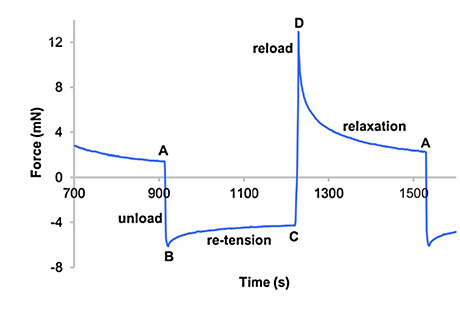Monitor - ISSN 1472-0221
The Newsletter for PC-Based Data Acquisition and Control
Issue 240, September 2018
Any comments or questions email monitor@windmillsoft.com.
You can download this issue as a pdf file from https://www.windmill.co.uk/monitor/monitor240.pdf.
Contents
* Investigating the Biomechanics of Human Tendons using the Microlink Data Aquistion system
* Your DAQ Questions Answered
* Data Acquisition News Round-Up
Investigating the Biomechanics of Human Tendons using the Microlink Data Acquistion system
The chief function of a tendon is to enable movement of bones. The tendon transmits the force produced by the muscle to the joint. While the tendon can impart forces on the cells, it is also possible for the cells to exert forces on the environment around them. Researchers have shown that placing sizeable repetitive loads on the tendon doesn't just cause movement but also influences a number of cell responses. Tension appears critical for the the cells to behave in this way.
Scientists from the Institute of Sports Medicine in Copenhagen and the University of Manchester have been trying to directly measure, for the first time, this phenomenom .
Lead researcher Antonis Giannopoulos and his collaborators made tendon constructs from human cells obtained from donors. It took around 2 weeks after seeding the constructs for them to be fully formed.
They designed a system to measure forces in these constructs. The data acquisition system comprised force transducers from Aurora Scientific, stepper motors with a motor controller, culture wells, and a Microlink 751 data collection system. The constructs were attached by their silk suture loops to the motor and force transducer via stainless steel hooks. The stepper motors applied strain via a threaded rod with a step resolution of 2.25 um. Deformation was applied at a rate of 56 um/s. Windmill software sampled force data collected by the Microlink at 1 Hz.

Credit: Giannopoulos A et al CC BY 4.0
The researchers used these mechanical tests to measure tension under different treatments. They successfully demonstrated the presence of cell-generated tension within the human tendon constructs. Their new system applied, detected and quantified the generated forces in real time, providing new insight into the field of tendon biomechanics. They concluded that the force monitor system is a useful tool to investigate tissue development and regeneration.

Credit: Giannopoulos A et al CC BY 4.0
The Microlink 751 data acquisition system is now just £295 including Windmill software. It lets: you measure temperature, strain, pressure, voltage, force and current through 16 analogue input channels; switch up to 32 digital outputs; monitor up to 32 digital inputs and count events with up to 8 counters.
More Information
Read more about the Microlink 751 data acquisition system.
Giannopoulos A et al, 2018. Cellular homeostatic tension and force transmission measured in human engineered tendon. Journal of Biomechanics, 20(1).
Your Data Acquisition Questions Answered
Question
Can your Microlink data logger scan continuously and simultaneously all of the following:
- Loads from Load Cells (4 channels)
- Deflections from LVDS (3 channels)
- Strains from strain gauges (9 channels)
Our most important question is : Does your data logger require any other intermediate or interface instrument or tool to be connected with the above mentioned instruments, in other words, please tell us if any other accessory is required for these connection to be valid and the data could be read and arranged in an excel sheet or text file, each data in a separate column.
Answer
Yes, the Microlink strain data loggers can do so. You will need a strain gauge connection box to interface the strain gauges and voltage signals. This is included with both the Microlink 751-SG package which connects to the computer over USB, and the Microlink 851-SG data logger which connects to the computer over Ethernet or Internet. The LVDTs should be DC rather than AC. If you use LVDTs with a 4-20mA output then you need to put this through a precision resistor (e.g. 100 ohms 0.1%) to give a 0.4 to 2V signal. You can generally connect load cells directly.
For full details of the data acquisition strain options see https://www.windmillsoft.com/
DAQ News Round-up
Welcome to our round-up of the data acquisition and control news. If you would like to receive more timely DAQ news updates then follow us on Twitter - @DataAcquisition - or grab our rss feed.
Enabling "internet of photonic things" with miniature sensors
'Whispering gallery mode resonators' recorded real-time temperature data and, mounted on a drone, mapped temperature distribution
Source: University of Washington
https://source.wustl.edu/
Simple, inexpensive technique opens new fields for piezo-sensors and energy harvesting
The inexpensive process allows the integration of piezoelectric components directly onto silicon chips.
Source: Eureka Alert
https://www.eurekalert.org/
Attachable sensors for monitoring plant growth
A team from Saudi Arabia has designed flexible, butterfly-shaped, attachable sensors that can measure plant growth, humidity and temperature. The sensors could help identify optimum growth conditions for individual plants, even in harsh environments.
Source: Nature Middle East
http://www.natureasia.com/
* Copyright Windmill Software Ltd
* Reprinting permitted with this notice included
* For more articles see https://www.windmill.co.uk/
We are happy for you to copy and distribute this
newsletter, and use extracts from it on your own web
site or other publication, providing the above notice
is included and a link back to our website is in place.
For previous issues by subject see https://www.windmill.co.uk/monitorindex.html
SUBSCRIBING OR CANCELLING SUBSCRIPTION Visit https://www.windmill.co.uk/newsletter.html and add or remove your e-mail address.
Windmill Software Ltd, PO Box 58, North District Office,
Manchester, M8 8QR, UK
Telephone: +44 (0)161 834 6688
Facsimile: +44 (0)161 833 2190
E-mail: monitor@windmillsoft.com
https://www.windmill.co.uk/
https://www.windmillsoft.com/
